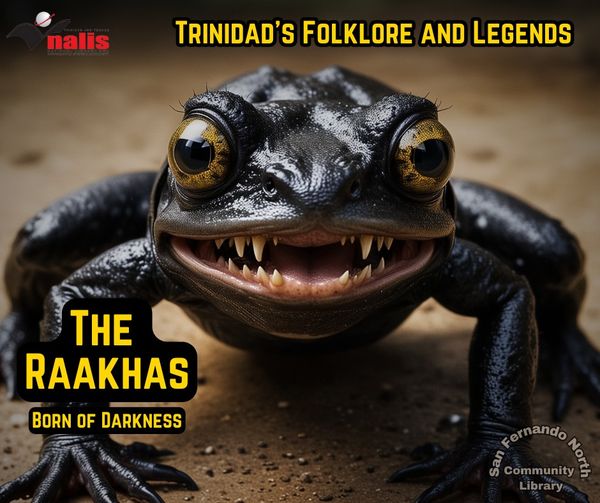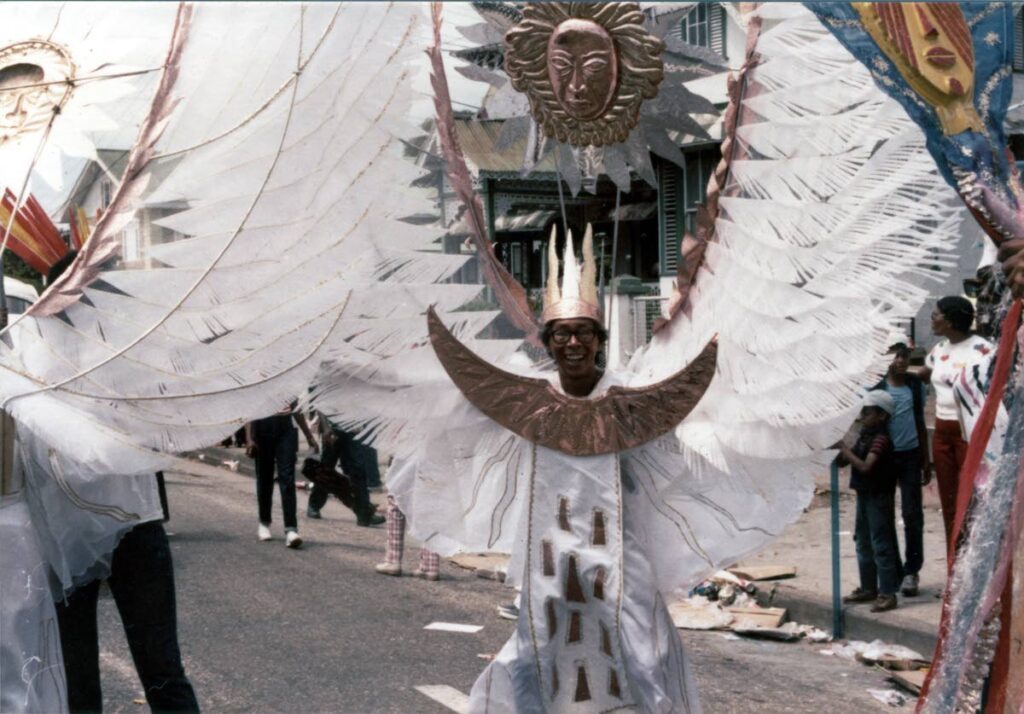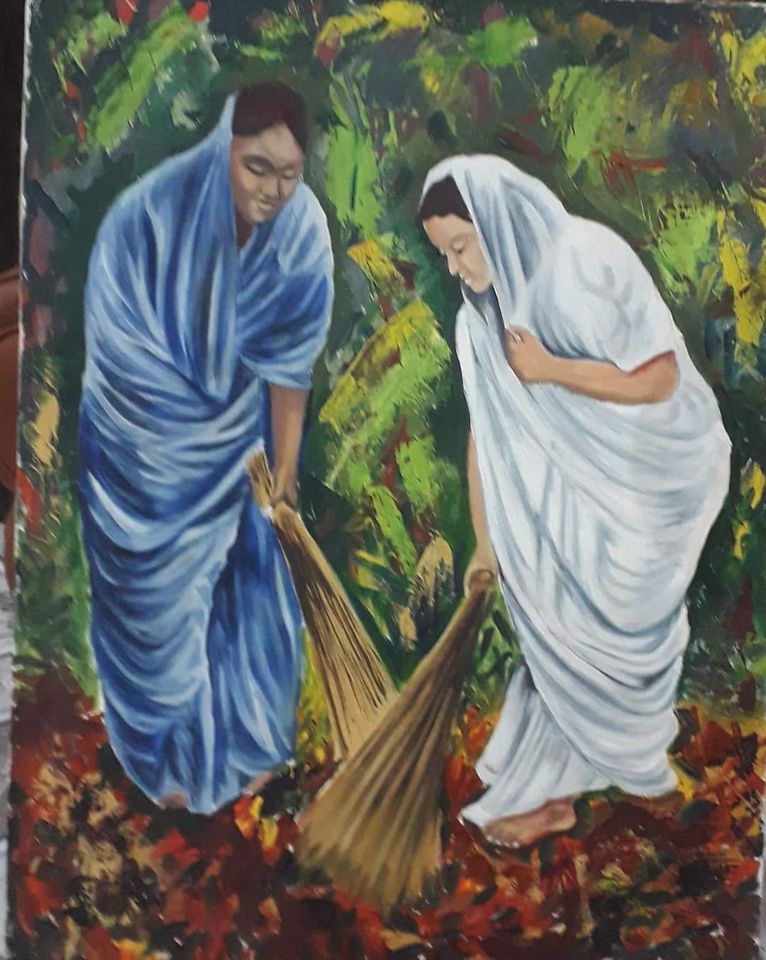|
A Personal Account:
I remember that night quite vividly. It was during the late 1950s in the Morne Diablo area, South Trinidad. My aunt had just given birth, and I was standing outside their home, listening to the pandemonium inside. From where I stood, I could hear the chaotic noises, but I didn’t see anything directly. I was told that my uncle, normally a strong man, was frozen in fear in the corner when he saw the newborn child. Vashti, the mother, was said to be slipping in and out of consciousness. Inside, Ms. Ingrid, the ‘chaamine’, was struggling to control the situation. She told me later that she tried in vain to hold down the child, but it scratched her fiercely and scurried under the bed. During a brief moment of silence, when the child had stopped screaming and growling, it was said to target the father with insults. With a disturbingly deep, unsettling voice it shouted: "Boysie! Wey yuh mudda? Watch yuh, yuh moorkh!" From outside, I could hear the cries, the screaming, the moving furniture. Ms. Ingrid said that earlier, as soon as the child was delivered, it asked her in ‘a big man’s voice’ what she was doing there. She said she never expected the raakhas to be that strong, that the “kala jaadu that griping Vashti was too much.” Ms. Ingrid described the creature as looking like a slippery, black ‘crapaud,’ with teeth like a dog. We were told to go ‘up de road’, away from the house. I heard later that when they eventually mustered the courage to look under the bed, the ‘thing’ was gone. The trauma of that night left my aunt mute for nearly two years, and my uncle, unable to cope with the stress, fell into alcoholism, which ultimately led to his death. Ms. Ingrid herself was never the same after that night. To be honest, nothing was right after that, especially with Auntie Vash—no amount of puja, or visits from priests and pundits could bring her back to her old self. She eventually passed away in 2004. To this day, the memory of that night haunts me—the eerie cries, the growls, the stories from Ms Ingrid, it was really something else yes.” - D. Bheepat ---------------------------------------------------------------- "The Raakhas" The tale of the “Raakhas” is a chilling legend that likely evolved with the East Indian indentured labourers who came to the Caribbean and was propagated by their descendants. This folklore may have been influenced by the “Rakshasa” of Indian mythology—demonic or ‘goblin-like’ beings known for their shape-shifting abilities, immense strength, and in some instances, an insatiable appetite for human flesh. In Trinidad, a Raakhas/Raa-khas is a sinister newborn creature, often resembling a young rat, monkey, or frog, with a complexion as dark as night. It bears a high, sloping forehead, and its menacing grin reveals four protruding teeth—two on the upper jaw and two on the lower. Its long fingernails, toenails, and hair add to its eerie appearance, and it may even possess a tail. Upon birth, the raakhas immediately attempts to flee, leaping through windows and scaling rooftops, all the while shrieking the names of its parents as a chilling omen of impending doom. The chaamine (midwife) faces a grim task: to kill the raakhas by strangling it or crushing its chest with a grinding stone (sil) the moment it is born. If the creature survives, it becomes a relentless predator, seeking to end the lives of its parents and others by clawing at their flesh and piercing their necks with its razor-sharp teeth. The child never lives beyond a few days; it either perishes naturally or is mercilessly destroyed by human hands. A child is cursed to become a raakhas as a result of its mother's dark karma. Have you ever heard of this tale? Further Reading: - Mahabir, K., & Khan, A. (2010). Indian Caribbean folklore spirits. Chakra Publishing House. - Pattanaik, D. (2003). Indian mythology: Tales, symbols, and rituals from the heart of the subcontinent. Inner Traditions. - https://www.nalis.gov.tt/.../Indian-Caribbean-Folklore (Source: San Fernando North Community Library, July 20, 2024) Dr David Picou plays mas with Peter Minshall on a trip back to TT. - KIM JOHNSON THE tributes have been paid on the death of my maternal uncle Prof David Picou, who died on May 4. He was one of the great Caribbean men, whose research into malnutrition saved millions of children’s lives in the Caribbean, Latin America, Africa and Asia, when starvation was rife. As my daughters’ obstetricians once told me, he was one of the region’s greatest scientists. And that’s fine and well-deserved, but it doesn’t give an idea of the man, who was no stuffy scientific nerd, all work and no play. No one mentioned, for instance, that Uncle David loved Carnival passionately, like many Chinese-Trinis. At his home was a collection of paintings of pan and mas, and copperwork by Ken Morris from his costumes. When he lived in Jamaica, after about 20 years, he began returning to Trinidad for every Carnival to play mas, starting with Peter Minshall’s Paradise Lost, until he moved back here. For that first band, he was part of the group that made a plaster of Paris mould for Peter Samuel – who had a damaged spine – so his Serpent in the Garden of Eden costume could be strapped on without hurting the masquerader. So the masman that was Prof Picou was never isolated from the academic. In 1981, for instance, there was a conference on Carnival at The UWI, and one presenter did not show up. I was working as a research assistant at The UWI at the time and I invited Uncle David to fill the spot. He did so, and spontaneously presented one of the most insightful analyses of the aesthetic considerations involved in designing a king-of-the-bands costume. Dr David Picou in Minshall's Lords of Light in 1985. - At first Uncle David came home under his own steam, but after a while he arranged every The UWI faculty of medicine meeting to be held in Trinidad in the Carnival season so that academics from around the world would get a taste of what he loved as much as his medical research. He would rigorously make attendees work without a break till about 2 pm. Then he’d say, “Ok, work done for the day – time to lime.” And he’d pour drinks. At night they’d all go to a calypso tent. He always played a section leader in the band in a large, ornate costume, which he’d take back to Jamaica. Those days there was a family joke that Uncle David’s sole topic of conversation was either the Carnival just passed, or the next one coming in six months’ time. And when he had people over to his home in University Close in Mona, and the rum started to flow, and the calypso was blasting on the stereo, he’d put on his costumes – as many as he could wear at the same time – and begin to dance. In The Sea he played a manta ray, with 15-foot wings, and he’d put it on to dance, spinning around, knocking over lamps and vases, crash! Smash! Once he fell off the truck on Carnival Monday and fractured two ribs. He was a doctor, so he knew what had happened. So what? He just bandaged it up and continued playing mas. He was a deeply social man; he loved to entertain, and he cooked like a pro. At the slightest excuse he’d invite people to his house and whip up an amazing four-course meal of Chinese food. Sometimes I’ve thought that his research into malnutrition made him acutely aware of the blessing that was a good meal. Every year in Mona he held an enormous Old Year’s Night party that lasted until lunch on New Year’s Day. I’d not gone to Jamaica yet, but I remember it because he’d get my parents to send up, with some BeeWee captain, pastelles, black pudding and souse for the fete. Then, after he returned home to live, around 1979, I think, he was one of the founders of his old school, Queen's Royal College’s, Men Who Cook fundraisers. Certainly, with his friend Prof Max Richards, he created the Max and Friends fundraiser fete for The UWI. Once, after Richards had become president of Trinidad and Tobago, Uncle David was in New York and invited him to where he was staying for a lime. As a visiting head of state, the US Secret Service had two bodyguards accompany Richards, and they stood outside the building shivering – it was winter.Uncle David went down and invited them to come inside and join the lime. He persuaded them they’d better do their duty in sight of the president.  Dr David Picou presents the plans for the Mt Hope hospital. - I could go on and on, because he also had a mischievous sense of humour and could regale you with amazing scenes from his life as a researcher. But I won’t. I’ll just end with one anecdote from when he was head of the Tropical Metabolism Research Unit in Mona.
At the time he worked with many working-class women who were overburdened with many, many children they couldn’t take care of. He’d prescribe contraceptives so they wouldn’t continue getting pregnant. One came to him complaining that the contraceptives weren’t working and she was pregnant once again, for the eighth or ninth time. “You made sure to take one of the tablets every day?” he asked the lady. “Yes doctor,” she replied. “Every day I make sure and push one up." (source: Newsday, May 14, 2024) The shoemaker - Trinidad and Tobago Newsday written by Valdeen Shears. March 2, 2024
Akanni Kamau was only 15 when he developed a love for craft. He made his first pair of slippers out of cardboard and hunted for scraps outside a shoe factory in St James when he decided to upgrade his product. He was so determined to hone his skills that he did a stint as a shoemaker just to learn the intricacies of how to "build" footwear. Soon the teen would go from cardboard slippers to his first pair of leather sandals, made from the scraps he had gathered. Kamau, now 63, told Business Day that his curious, teenage mind was at that time fixated on African culture and art. The self-taught craftsman said he read avidly on the topics and scored any publication he could get his hands on that offered teachings on craft. With no internet in those days to offer DIY tutorials, he persevered and did all his first creations by trial and error. "It started with just a thought that I could make sandals, beautifully crafted, artistic sandals and slippers. That I could one day see my creation on the feet of my countrymen and women. I lived at Nizam Street, St James at that time and the street behind there, Nepaul Street, had a shoe factory. I would go many days after school and gather scraps, just so I could use them to make more sandals and slippers. I experimented for two years, until I made one that I wore to market my work. It drew compliments and soon enough I was being asked to provide the same and similar designs for others," he recalled. This was all the encouragement he needed to recognise that he had found himself a viable business. The income was slow but sure, he said, so he worked as an air condition technician during the day and would excitedly get home to begin or complete a job for his quickly growing clientèle. Leather craftsman Akanni Kamau said while his creations are based on his own ideas, he is influenced by the wants and needs of his customers. Six years later, after building a customer base, Kamau said he knew he had to go all in and opened his first shop at Patna Street. He stayed there for over 15 years. "You have to truly love creating, satisfying your customers, for you to want to stay in this industry. I knew from the onset that any day job I did would soon take a back burner for my craft. It was no hard decision to leave my job then, my fixed income, my security blanket and branch out on my own doing my craft. I knew it would one day call for my full commitment and that day had reached." Kamau said while the current economy may somewhat negatively impact on the industry's sustainability, the market for craft is limitless and offers diverse opportunities. He firmly believes customers' needs and preference for durability keep the livelihoods of craftsmen and women going. "A satisfied customer is not one who has to return to buy every other month, but one who is loyal because the product bought is durable and lives up to his standards. People who love leather footwear see the sense in buying a sandal or slipper that will last longer than a month or two like most store bought shoes made out of plastic and compressed cardboard," reasoned the craftsman. Kamau is a father of two and a proud grandfather of seven. While none of his children followed in his footsteps, Kamau has passed on his legacy through others by training any youth who showed an interest. He recalled a group of young trainees who would "race each other to finish a project first." He would laugh at their antics, he said, and then sternly correct errors made in their haste to out do the other. Sadly, Kamau said, none of his trainees stuck it out. He said he suspects its because they could not see a clear way to secure a market and became discouraged. "Securing a market is often a deterrent for most creatives. They second guess their gifts, but if the ancestors give you, they will provide the means and opportunities for you to sustain yourself and your livelihood," he stressed. In the late 1980s, Kamau relocated to Clarence Street for five years and then again to De Norbriga Street, Morvant, where he is currently based. The move to Morvant meant he had to secure a new customer base. Some loyal customers followed him to Morvant, while some didn't. This though, did not faze the resilient craftsman, as he soon saw the support of his new community, several of whom wanted customised footwear. From time to time he takes a chance and markets his goods at lower Frederick Street, Port of Spain. Kamau's creations, while based on his own ideas, are very much influenced by what his customers want. So much so, that one customer took a photo of a pair of leather sandals in a popular shoe store in the city and sent it to him via social media. It was with a huge smile that she paid for her customised sandals two weeks later, he said. The artisan said he gets extreme satisfaction matching his creations to the personality of its wearer. Some of his work boasts brightly-coloured splashes, which he said women often gravitate towards. Kamau said he is sure that the versatility of any leather slippers or sandals will more than likely match any outfit in the average person's wardrobe. "My female customers can no doubt find a handbag, an earring, a chain, some fancy top they had been saving for a special occasion, to wear with one of the more decorative slippers or sandals. The lifted ones, with raised heels or wedge sandals are often a big hit for the ladies." It has not been all good times for his near 50-year journey, though. There have been struggles and he wishes that craftsmen and women would voice their need for a space of their own, particularly within the capital city. Some of the sandals made by leather craftsman Akanni Kamau. PHOTO BY ANGELO M MARCELLE As any typical Trini child my mother believed in certain traditonal practices associated with the advent of a new year. She ensured that all laundry was done and a thorough cleaning of the home be done on New Years Eve followed by burning of incense throughout the house. This was her way of conducting a spiritual cleansing of the home to get rid of negativity and any evil forces.
On New Years Day we were not allowed to sweep the house since she had grown up to believe that you would sweep away the good luck the new year ushered in. Also if you did laundry on New Years Day you will be washing away the life of a family member in the new year. My father on the other hand believed that your wallet must always have money in it when the old year ended. This he said was to l ensure that you will always have money in your wallet throughout the New Year. These are but a view of the superstitious beliefs I remembered growing up. What superstitious beliefs do you remember that is associated with New Years Eve or as we say in Trinbago Old Years Day. ? It would be interesting to hear the beliefs from different parts of the world since we have members who live in many countries other than T&T so please use this opportunity to share your beliefs. Painting courtesy Rudolph Bissessarsingh (Source: Virtual Museum of Trinidad & Tobago, Dec 28 2023) |
T&T news blogThe intent of this blog is to bring some news from home and other fun items. If you enjoy what you read, please leave us a comment.. Archives
May 2025
Categories
All
|












 RSS Feed
RSS Feed